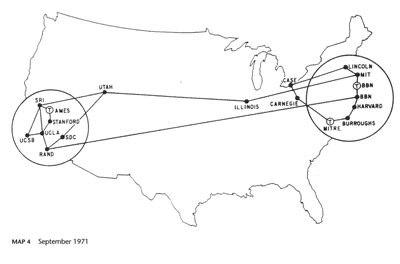Think you know about deliverability?
Check out the tweets from my AMA webinar sponsored by Message Systems today.
Thanks to the AMA and Message Systems for having me.
Check out the tweets from my AMA webinar sponsored by Message Systems today.
Thanks to the AMA and Message Systems for having me.
Many aspects of email are a lot older than you may think.
There were quite a few people in the early 1970s working out how to provide useful services using ARPANET, the network that evolved over the next 10 or 15 years into the modern Internet.
They used Requests for Comment (RFCs) to document protocol and research, much as is still done today. Here are some of the interesting milestones.
April 1971 [rfc 114]RFC 114 A File Transfer Protocol.[/rfc] One of the earliest services that was deployed so as to be useful to people, rather than a required part of the network infrastructure, was a way to transfer files from one computer to another. In the [rfc 114]earliest versions[/rfc] of the service I can find it could already append text to an existing file. This was soon used for sending short messages, initially to a remote printer from where it would be sent by internal mail, but soon also to a mailbox where they could be read online.
August 1971 [rfc 221]RFC 221 A Mail Box Protocol, Version-2[/rfc] had this prescient paragraph:
Each month, we like to focus on a core email feature or function and present an overview for people looking to learn more. This month, we addressed authentication with SPF.
We also talked about feedback mechanisms, and the importance for senders to participate in FBL processes.
In our ongoing discussions about spam filters, we took a look at the state of our own inboxes and lamented the challenge spam we get from Spamarrest. We also pointed out a post from Cloudmark where they reiterate much of what we’ve been saying about filters: there’s no secret sauce, just a continuing series of efforts to make sure recipients get only the mail they want and expect to receive. We also looked at a grey area in the realm of wanted and expected mail: role accounts (such as “marketing@companyname.com”) and how ESPs handle them.
As always, getting into the Gmail inbox is a big priority for our clients and other senders. We talked a bit about this here, and a bit more about the ever-changing world of filters here.
On the subject of list management, we wrote about the state of affiliate mailers and the heightened delivery challenges they face getting in the inbox. We got our usual quota of spam, and a call from a marketer who had purchased our names on a list. You can imagine how effective that was for them.
And in a not-at-all-surprising development, spammers have started to employ DMARC workarounds. We highlighted some of the Yahoo-specific issues in a post that raises more questions.
We also saw some things we quite liked in June. In the Best Practices Hall of Fame, we gave props to this privacy policy change notification and to our bank’s ATM receipts.
We also reviewed some interesting new and updated technology in the commercial MTA space, and were happy to share those findings.
One of the ongoing challenges sending email, and managing a high volume outbound mail server is dealing with the ongoing changes in filtering. Filters are not static, nor can they be. As ISPs and filtering companies identify new ways to separate out wanted email from unwanted email, spammers find new ways to make their mail look more like wanted mail.
This is one reason traps are useful to filtering companies. With traps there is no discussion about whether or not the mail was requested. No one with any connection to the email address opted in to receive mail. The mail was never requested. While it is possible for trap addresses to get on any list monitoring mail to spam traps is a way to monitor which senders don’t have good practices.
New filtering techniques are always evolving. I mentioned yesterday that Gmail was making filtering changes, and that this was causing a lot of delivery issues for senders. The other major challenge for Gmail is the personalized delivery they are doing. It’s harder and harder for senders to monitor their inbox delivery because almost every inbox is different at Gmail. I’ve seen different delivery in some of my own mailboxes at Gmail.
All of this makes email delivery an ongoing challenge.